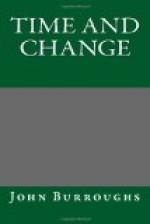Animal life is often curiously interdependent. I asked our guide in the Adirondacks if there were any ravens there. “Not nearly as many as there used to be,” he said, and his explanation of their disappearance seems thoroughly scientific; it was that the wolves and the panthers kept them in meat, and now that these animals had disappeared, the ravens had little to feed upon. If the moose were compelled to graze from off the ground, like a sheep or a cow, the species would probably soon become extinct. Osborn thinks it probable that the huge beast called titanothere finally became extinct early in Tertiary times owing to the form of its teeth, which were of such a type that they could not change to meet a change in the flora upon which the creature fed. Of course we shall never know what narrow escapes our race had from extinction in the remote past; some forms have ended in a blind alley, like the sea-urchin and the oyster. Arthropoda have continued to evolve and have reached their high-water mark of intelligence in bees and ants. The vertebrates went forward and have culminated in man. Bergson thinks that in the vertebrates intelligence has been developed at the expense of instinct, and that in the invertebrates instinct has been perfected at the expense of intelligence.
Are we not compelled to adopt what is called the monophyletic hypothesis, that is, that our line of descent started from one pair, male and female, somewhere in the vast stretch of geologic or biologic time, and to reason that, had that pair been out of the race, we should not have appeared?
Can we narrow life to a single point, a single cell, in the past? Was there one and only one first bit of protoplasm? If we were to say that life first appeared on the globe in Cambrian times, just what should we mean? That it began as a single point, or as many points? When we say that the primates first appeared in Eocene times, do we mean that one single primate appeared then? If so, what form went immediately before him? This is all a vain speculation.
Does man presuppose all the vertebrate sub-kingdom? Was he safe as long as one vertebrate form remained? Are his forebears many, and not one pair? Can we think of his ancestry under the image of a tree, and of him as one of the many branches? If so, nothing but the destruction of the tree would have imperiled his appearance, or the lopping off of his particular branch. Probably all such images are misleading. We simply cannot figure to ourselves the tangled course of our biological descent. If thwartings and accidents arid delays could have cut man off, how could he have escaped? We cannot think of man as one; we are compelled to think of him as many; and yet in all our experience the many come from the one, or the one pair.
How thick the field of animal life in the past is strewn with extinct forms!—as thick as the sidereal spaces are strewn with the fragments of wrecked worlds! But other worlds and suns are spun out of the wrecked worlds and suns through the process of cosmic evolution. The world-stuff is worked over and over. Extinct animal forms must have given rise to other, allied forms before they perished, and these to still others, and so on down to our time.




